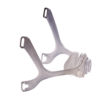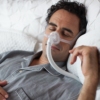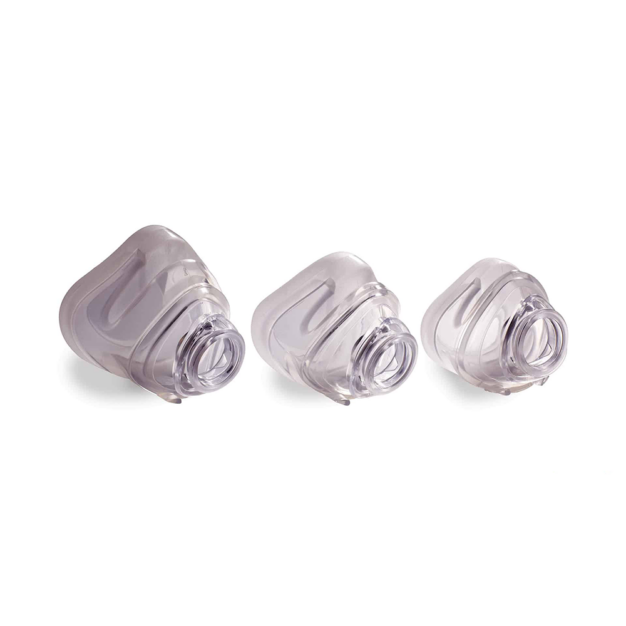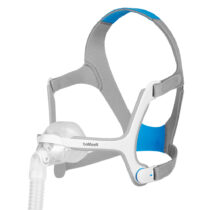Philips Respironics Wisp Nasal Mask (Silicone Frame)
- Comfort 4.0 of 5, freedom of movement 4.5 of 5- Minimalist design: This mask has been developed in such a way that the minimal number of parts required for a nasal mask have been incorporated in the design . This makes the Philips Wisp an unobtrusive CPAP mask, allowing you to comfortably wear glasses and offering freedom of movement.
- Fits almost everyone: Due to the well-thought-out shape of the mask cushion, it fits almost all nose types and creates a seal below the bridge of the nose, resulting in minimal contact area.
- Easy to put on and take off: The headgear is easily attached to the mask frame with the help of hooks. When taking it off, these hooks can be unclipped quickly and easily


We recommend those accessories
Product description
Especially suitable if you only breathe through your nose at night, wear glasses, have a beard or are claustrophobic. This mask has been developed so that only the most essential parts of a nasal mask are present. This makes the Philips Wisp an inconspicuous CPAP mask, allows you to wear glasses without any problems and also allows you to move freely. The frame material is available in either fabric or silicone. Both materials make the frame flexible and prevent pressure points from developing on the face. Due to the well thought-out shape of the mask cushion, it adapts to almost all nose types and fits snugly around the nose, which means the area of contact is minimalised.
The headgear is easily attached to the mask frame with the help of hooks. When taking it off, these hooks can again be unclipped quickly and easily. The hose/ tube can easily be unclipped from the elbow swivel joint, so that you don’t have to remove the whole mask for nightly toilet visits. The mask comprises of three parts only, which makes cleaning quick and easy. The Wisp Nasal Mask comes with either a silicone or fabric frame (and an exhalation valve, i.e. as a “vented” mask). Each mask comes with three mask cushions in sizes S, M and L.
Compare with similar products
Specifications
Scope of delivery
Mask frame, mask cushion, headgear, elbow swivel joint - connecting pieceCustomer reviews (1)
Write a review
Return Policy
For hygiene reasons, this product is delivered in sealed hygienic packaging. You are therefore NOT able to return the product if the sealed hygienic packaging has been unwrapped. Provided the sealed packaging is unopened, you have the option to return the product to us within 30 days of receipt.
This does not affect your statutory rights, most notably with regard to product defects.
You can find further details of your right to return goods in our GTC.
Instructions for use
Product safety
Manufacturer: Respironics Inc., 1001 Murry Ridge Lane, Murrysville, PA 15668 USA, info@philips.com
Person Responsible: Respironics Deutschland GmbH & Co. KG, Gewerbestrasse 17, 82211 Herrsching, Germany, info@philips.com
Additional safety information can be found in the instructions for use.
More information
CPAP masks are wear parts. The service life of a CPAP mask is therefore 5 to 6 months. Usual wear and tear, particularly of mask cushions (e.g. a tear in the mask cushion after 3 months of use) or head straps (baggy strap after several months of use) does not constitute a material defect.
Due to the production methods used, CPAP masks may smell of plastic or silicone. If this smell does not evaporate after initial use, it often helps to clean the CPAP mask under fresh water (with the addition of SomnoSept, if necessary) and to leave to dry.
Warning
Magnets with a magnetic field strength of 400 mT are used in the mask. With the exception of the devices identified in the contraindication, ensure the mask is kept at least 6 inches (approx. 15.24 cm) away from any other medical implants or medical devices that can be impacted by the magnetic fields to avoid possible effects from localized magnetic fields. This includes household members, caregivers, and bed partners that may be in close vicinity to patients that use the masks.
Contraindication
- Pacemakers
- Implantable cardioverter defibrillators (ICD)
- Neurostimulators
- Magnetic metallic implants/electrodes/valves placed in upper limbs, torso, or higher (i.e. neck and head)
- CSF (cerebral spinal fluid) shunts (e.g., VP (ventriculo peritoneal) shunt)
- Aneurysm clips
- Embolic coils
- Intracranial aneurysm intravascular flow disruption devices
- Metallic cranial plates, screws, burr hole covers, and bone substitute devices
- Metallic splinters in the eye
- Ocular implants (e.g., glaucoma implants, retinal implants)
- Certain contact lenses with metal
- Implants to restore hearing or balance that have an implanted magnet (such as cochlear implants, implanted bone conduction hearing devices, and auditory brainstem implants)
- Magnetic denture attachments
- Metallic gastrointestinal clips
- Metallic stents (e.g., aneurysm, coronary, tracheobronchial, biliary)
- Implantable ports and pumps (e.g., insulin pumps)
- Hypoglossal Nerve Stimulators
- Devices labeled as MR (magnetic resonance) unsafe
- Magnetic metallic implants not labeled for MR or not evaluated for safety in a magnetic field
Click here for additional information.
Instruction manual
Here you can find detailed instructions for using the Philips Respironics Wisp Nasal Mask.

























 Welcome to SomniShop
Welcome to SomniShop
Write a comment